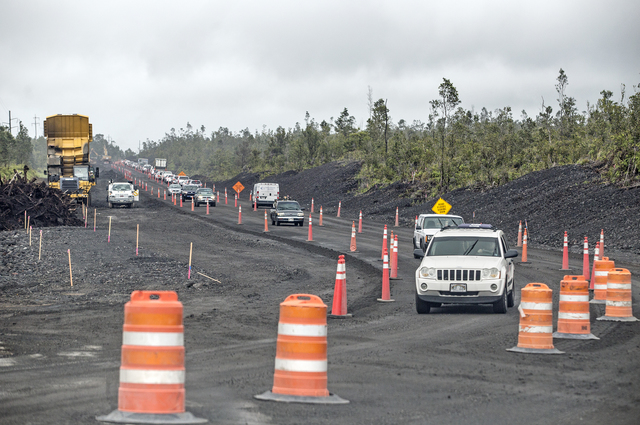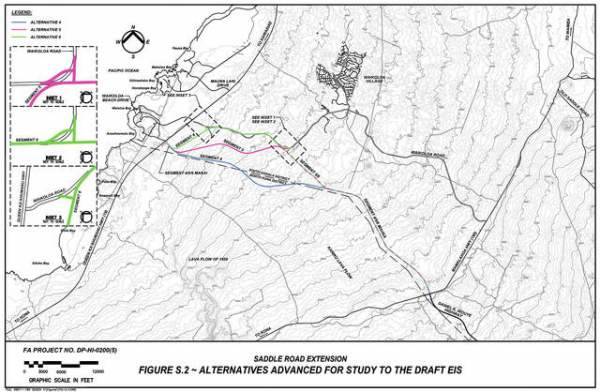WAIKOLOA VILLAGE — Residents who wanted their voices heard on the Saddle Road extension project, which is moving expeditiously toward final design and construction, got their platform Wednesday night. ADVERTISING WAIKOLOA VILLAGE — Residents who wanted their voices heard on
WAIKOLOA VILLAGE — Residents who wanted their voices heard on the Saddle Road extension project, which is moving expeditiously toward final design and construction, got their platform Wednesday night.
Roughly 100 people showed up to Waikoloa Elementary and Middle School to offer input on the ongoing environmental impact statement process concerning the extension. The project received well-rounded support from speakers, something Ron Terry of Geometrician Associates said has been a common theme.
“I think people realize in almost every category of impact this improves on the existing situation,” he said.
While most individuals spoke, some entities offered written testimony at the public hearing.
“The Kona-Kohala Chamber of Commerce is in full support of the Saddle Road Extension project,” a letter from the chamber read. “The Saddle Road is an important cross-island link between the labor force and affordable housing in East Hawaii and the job market in West Hawaii.”
The extension, which is estimated to cost as much as $89 million, is projected to begin construction next year and be ready for travel as early as 2020. The federal government has committed to picking up 80 percent of the tab.
The draft EIS noted the road should carve about 6.5 minutes off cross-island commute times on average and decongest roadways on other parts of the island, namely Waimea, as traffic islandwide is expected to spike in coming years.
More than 4,000 vehicles currently use the existing Saddle Road on a daily basis, and some studies guess as many as 20,000 cars might traverse it by 2035.
Most of the discussion Wednesday evening focused on which of the three remaining alternate routes best serves surrounding communities.
Alternative 4 connects to Queen Kaahumanu Highway directly along the border between South Kohala and North Kona without intersections.
Alternative 5 runs north of that route, connecting to Waikoloa Road near mile marker 3. Alternative 6 utilizes two miles of Waikoloa Road west of mile marker 3, according to information provided by the Hawaii State Department of Transportation.
“Alternative 4 reduces the number of intersections and I think that’s important for safety. It’s important for controlling speeds and it’s important for controlling costs. I think it’s the cheapest option,” said Rich Bell, who represented People’s Advocacy for Trails Hawaii at the meeting. “From a cyclist’s point of view, I’m very grateful for the inclusion of cyclists in our roadways and looking forward to improved safety and improved recreation.”
Terry said each alternative has pros and cons as far as traffic and intersection mitigation, and that it’s too complex to make a blanket statement that one route is better in that regard than another.
“Alternative 5 offers a connection back to Waikoloa Village that could be important for people traveling between Waikoloa Village and Hilo. But it does involve one more intersection, more cost because of that, and the potential for congestion at the intersection,” Terry said. “But it takes away some traffic congestion that might occur at Waikoloa Road and Queen Kaahumanu Highway, so it’s a very complicated interaction.”
Mary Wills Schulher, a resident of Waikoloa Village, also favored alternative 4 because it keeps traffic and the contents of that traffic further away from the residential area.
That traffic, namely garbage trucks and military transports, currently uses Waikoloa Road to access Queen Kaahumanu Highway.
“It’s what we don’t know about what they’ll be bringing on that road that gives me concern,” Schulher said. “Once the energy waste facility is completed, I’m also concerned about the volume of the garbage trucks that will be coming from Hilo.”
Schulher was referencing a proposed bio-energy facility at the Waikoloa quarry with an existing road connecting the site to Waikoloa Road. Terry said alternatives 5 and 6 would provide garbage trucks with ready access to the site, adding it isn’t clear yet how they would access the site if alternative 4 was chosen.
Terry said, however, he believes the connectivity issue could be negotiated if alternative 4 was selected, but that it still has to be worked out.
Some who spoke brought up issues besides which route should be selected — mentioning concerns like overall cost, the selection between concrete and pavement for portions of the work, and a proposal for a cloverleaf at the intersection of Daniel K. Inouye Highway and Mamalahoa Highway.
Gregory Fleming, who lives in Hilo and works at Pohakuloa Training Area, said his primary worry was the safety of his co-workers, a concern tied to parking areas along Saddle Road.
“What I’d like to see in terms of reducing the risk to the employees is reducing the number of vehicles on the road and also allowing employees to park their vehicle and ride out,” he said. “I’d like the federal highways and the state to consider a number of ‘park and rides’ built so that employees could park and then jump on a shared ride … to get back and forth to work.”
The public comment period for the EIS ends on June 7. Those who would like to submit written testimony may do so by contacting J. Michael Will at Michael.Will@dot.gov or Darell Young at Darell.Young@hawaii.gov.




